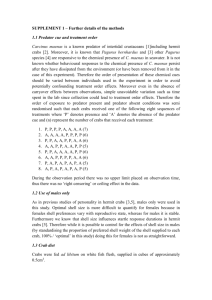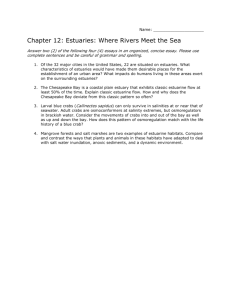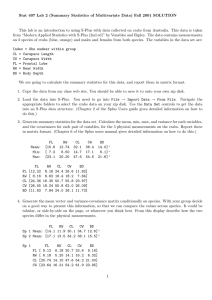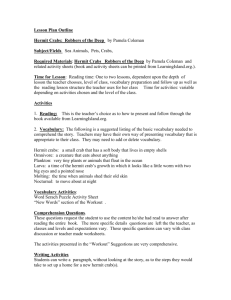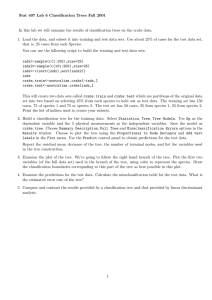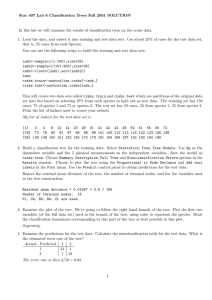Status of the European Green Crab in Oregon and Washington Estuaries
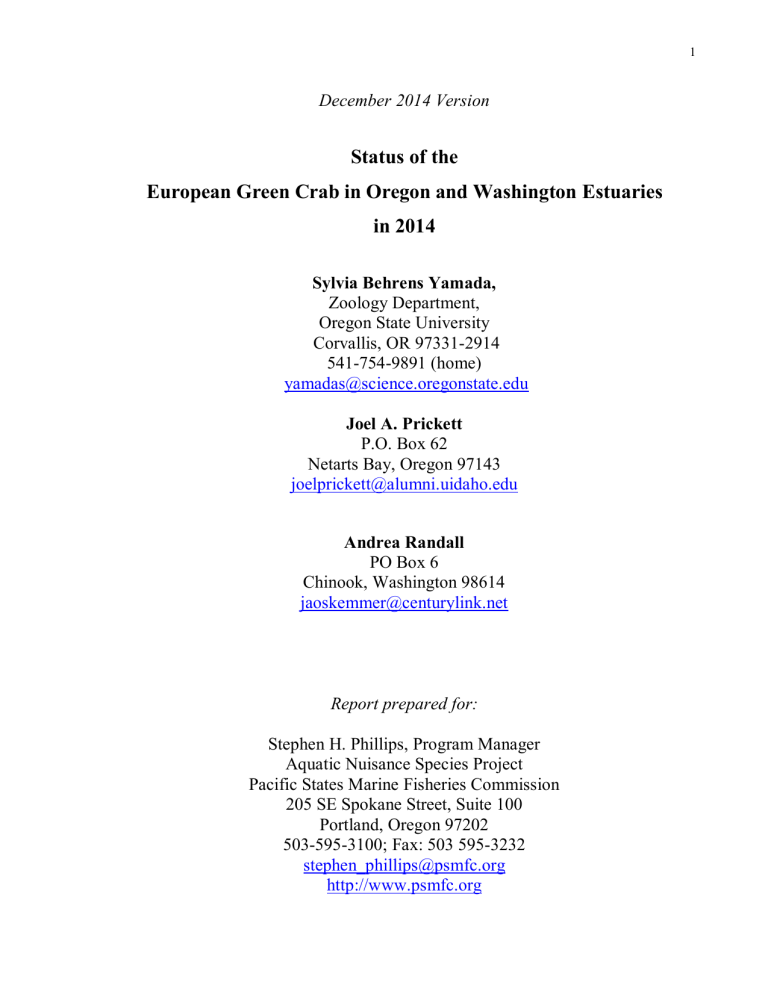
December 2014 Version
Status of the
European Green Crab in Oregon and Washington Estuaries in 2014
Sylvia Behrens Yamada,
Zoology Department,
Oregon State University
Corvallis, OR 97331-2914
541-754-9891 (home) yamadas@science.oregonstate.edu
Joel A. Prickett
P.O. Box 62
Netarts Bay, Oregon 97143 joelprickett@alumni.uidaho.edu
Andrea Randall
PO Box 6
Chinook, Washington 98614 jaoskemmer@centurylink.net
Report prepared for:
Stephen H. Phillips, Program Manager
Aquatic Nuisance Species Project
Pacific States Marine Fisheries Commission
205 SE Spokane Street, Suite 100
Portland, Oregon 97202
503-595-3100; Fax: 503 595-3232 stephen_phillips@psmfc.org
http://www.psmfc.org
1
2
Executive Summary
Once a non-native species arrives and survives in an area, its long-term persistence depends on its recruitment success. If conditions are not favorable for recruitment it will ultimately disappear. The European green crab ( Carcinus maenas ) has a six-year life span and has persisted at low densities in Oregon and Washington coastal estuaries for the past 17 years.
After the arrival of the strong founding year class of 1998, significant self-recruitment to the
Oregon and Washington populations occurred only in 2003, 2005, 2006, and 2010. Warm winter water temperatures, high Pacific Decadal Oscillation and Multivariate ENSO (El Niño
Southern Oscillation) Indices, late spring transitions and weak southward shelf currents in
March and April are all correlated with the these strong year classes and vice versa (Behrens
Yamada and Kosro 2010). Right now, green crabs are still too rare to exert a measurable effect on the native benthic community and on shellfish culture in Oregon and Washington. However, this could change if ocean conditions were to switch to a high PDO and strong El Niño patterns.
For example, green crabs were first documented in New England in 1817, but it took warm ocean conditions during the 1950’s for their numbers to build to a level at which they decimated the soft-shelled clam industry.
Extensive surveys by Fisheries and Oceans Canada found green crabs in all the major inlets on the west coast of Vancouver Island and around Bella Bella on the Central Coast, but so far none have been discovered in the inland sea between Vancouver Island and the mainland.
Therefore, outreach efforts should continue to prevent the establishment of this invader in these inland waters via ballast water, shellfish transport or other human-mediated vectors.
Even though green crab abundance in Oregon and Washington is still low when compared to Europe, eastern North America, Tasmania, California and the west coast of
Vancouver Island, it is imperative to continue monitoring efforts for two reasons:
1) to elucidate the process of range expansion and population persistence of this model nonindigenous marine species with planktonic larvae, and
2) to predict the arrival of strong year classes from ocean conditions and alert managers and shellfish growers of possible increases in predation pressure from this invader.
3
Date
Professional and Outreach Activities by Sylvia Behrens Yamada in 2014
Talks / Activities Location
April 3-5, 2014 Presented poster:
“
Status of the Green Crab in the Pacific
Northwest”
with Graham Gillespie,
Department of Fisheries and Oceans,
Canada
April 7, 2014 Presented talk on Green crab life history.
June 15-17, 2014. Trapped for European green crabs in
Argyle Lagoon, Marine Reserve, San
Juan Island, Washington.
Pacific Estuarine Research
Society Meeting, Hallmark
Resort, Newport, Oregon
Sally Hacker’s “Marine
Biology” class (Bi 450)
Hatfield Marine Science Center,
Newport, Oregon
Friday Harbor Labs, San Juan
Island, Washington
June 25-27, 2014
“Status of the European green crab in the Pacific Northwest”
Presentation and field sampling exercise.
John Chapman’s
“ Aquatic
Biological Invasions class” (FW
421/521) Hatfield Marine
Science Center, Newport,
Oregon
Introduction
European green crabs ( Carcinus maenas) made their way to the east coast of North America in sailing ships in the early 1800’s (Say 1817). They arrived in San Francisco Bay during the 1980’s, most likely via aerial shipment of Atlantic seafood or baitworms. From there, green crabs spread naturally via larvae carried in ocean currents, and by 2000, had dispersed as far north as Port Eliza on the northern west coast of Vancouver Island, British Columbia. Presently, green crabs are found around the Bella Bella area on the Central British Columbia coast. It is estimated that their potential range could include Southeast
Alaska (Behrens Yamada 2001, Carlton & Cohen 2003).
The green crab is a voracious predator that feeds on many types of organisms, including commercially valuable bivalve mollusks (e.g., clams, oysters, and mussels), polychaetes, and small crustaceans (Cohen et al. 1995). It also competes with native juvenile Dungeness crabs and shore crabs for food and shelter
(McDonald et al. 2001, Jensen et al. 2002, Behrens Yamada et al. 2010). Larger, more aggressive native crab species such as the red rock crab ( Cancer productus ) and the Pacific brown rock crab ( Cancer antennarius ), have been shown to offer biotic resistance to this invader, but only in the cooler and more saline lower parts of estuaries (Hunt and Behrens Yamada 2003; Jensen, McDonald and Armstrong
2007). Scientists, managers and shellfish growers are concerned that increases in the abundance and distribution of this efficient predator and competitor could permanently alter native communities and threaten commercial species such as juvenile Dungeness crab, juvenile flatfish and bivalves (Lafferty and
Kuris 1996, Jamieson et al. 1998, Behrens Yamada et al. 2010).
On the West Coast, the northward range expansion of green crabs during the 1990’s is linked to favorable ocean conditions for larval transport during El Niño events (Behrens Yamada et al. 2005,
4
Behrens Yamada and Kosro 2010). Warm temperatures and strong northward moving coastal currents
(>50 km/day) during the 1997/1998 El Niño were correlated with the appearance of a strong cohort of young green crabs in Pacific NW estuaries in the summer of 1998 (Behrens Yamada and Hunt 2000,
Behrens Yamada et al. 2005). Localized recruitment has occurred in embayments from Coos Bay to the
Central Coast of British Columbia. Year classes were more abundant following the warm winters and springs of 2003, 2005, 2006 and 2010 (Behrens Yamada & Gillespie 2008; Behrens Yamada & Kosro
2010).
Goals
The goal of this study is to document the present, and predict the future status of the European green crab in the Pacific Northwest.
This is accomplished by:
1.
Estimating the size/age structure and relative abundance of green crabs in Oregon and
Washington estuaries by using baited Fukui fish traps (Tables 2 and 4).
2.
Collaborating with scientists from Oregon Department of Fish and Wildlife, Washington
Department of Fish and Wildlife, and Fisheries and Oceans Canada as well as with shellfish growers and sports fishers in order to compile all existing green crab data for the Pacific
Northwest (Table 3) .
3.
Estimating year-class strength of 0-age (young-of-the-year) green crabs at the end of their first growing season by setting crayfish and pit-fall traps in the high intertidal zone at the end of summer and early fall (Figure 2).
4.
Comparing patterns in the recruitment strength of 0-age crabs over time and correlating them to ocean conditions: winter surface water temperatures, Pacific Decadal Oscillation Index for
March, Day of Spring Transition and alongshore currents for March and April (Appendix 5).
5
Figure 1. Major sampling sites in Oregon and Washington
6
Sampling Methods for Green Crabs
Our sampling effort in 2014 included one Washington and four Oregon estuaries: Willapa,
Tillamook, Netarts, Yaquina and Coos Bay (Figure 1). All estuaries were sampled at least twice during the 2014 trapping season (Appendix 2). In each estuary, we selected study sites within various habitat types and tidal levels. Since green crabs are rare and patchily distributed, we did not choose our sites randomly. Instead, we preferentially sampled sites that have harbored green crabs in the past such as tidal marshes, gradually sloping mudflats and tidal channels where salinities remain above 15 ‰ and water temperatures range between 12 o
-22 o
C in the summer
(Behrens Yamada and Davidson 2002). Green crabs are noticeably absent from the cooler, more saline mouths of estuaries, which are dominated by the larger and more aggressive red rock crab, Cancer productus (Hunt and Behrens Yamada 2003).
Since C. maenas larvae settle high on the shore (Zeng et al. 1999), and crabs move into deeper water as they age (Crothers 1968), we adapted our collecting methods and locations to effectively sample all age classes of C. maenas. Since traps differ in their sampling efficiency for different sizes of crabs, we used two trap types (Table 1). Folding Fukui fish traps, with their wide slit-like openings, work well for adult crabs larger than 40 mm carapace width (CW), while crayfish traps with their small mesh size (0.5 cm) retain 0-age green crabs. Green crabs start entering these baited traps when they are around 30 mm in carapace width. Typically, we would trap larger adult crabs in the mid to low intertidal and subtidal zones with folding Fukui fish traps and 0-age green crabs in the high intertidal with crayfish traps at the end of their first growing season (Appendix 2).
Table 1. Types of traps used for sampling C. maenas in Oregon and Washington estuaries.
Size selectivity is given in carapace width (CW).
Trap Type
Fukui Fish trap
Frabrill
Crayfish
Description Dimensions Tidal
Height
63 x 46 x 23 cm Low to subtidal
Size
Selectivity
>40 mm Plastic mesh (2 cm) with two slit openings (45 cm)
Wire mesh (0.5 cm) cylinder with two openings expanded to 5 cm
21 cm diameter
37 cm long
Medium to high
20-70 mm trap
On gravel shores, we added rocks to the crayfish and fish traps to weigh them down and to provide shelter for the crabs. On soft sediment, we pinned the traps down with thin metal stakes.
We cut fish carcasses into sections and placed them into egg-shaped commercial bait containers
(15 x 8 mm). Holes (0.5 cm) in the sides and lids of the containers allow bait odors to diffuse.
One bait container with fresh bait was placed in a trap and left for one tidal cycle (typically 24 hours). We retrieved the traps at low tide, identified all crabs and other by-catch to species and noted the sex, carapace widths (CW) and molt stage of all green crabs (Appendix 3). Green crabs were measured between the tips of their fifth anterio-lateral spines using digital calipers.
Native crabs and other by-catch were released while green crabs were removed from the ecosystem and destroyed.
7
Coos
Yaquina
Netarts
Tillamoook
Willapa
Grays
Harbor
Total
Table 2. Relative Green Crab abundances (# per 100 trap-days) for study sites in Oregon and Washington estuaries. Data for Grays Harbor 2002 and Willapa Bay 2002-2003 and 2013 were kindly supplied by Washington Department of Fish and Wildlife and those for Willapa
Bay in 2004, by P. Sean McDonald. Funding constraints did not allow us to sample Grays
Harbor every year. Asterisk indicates that most of the crabs came from repeatedly trappings of known “hot-spot”, thus inflating abundance estimates.
Estuary
2002 2003
9
(180) (203)
Number of crabs trapped over number of traps deployed
2004
(137)
2005
9
(242)
2006
22
(273)
2007
52
(246)
2008
65
(276)
2009
18
(292)
2010
6
(259)
2011
18*
(244)
2012
41*
(213)
2013
12*
(173)
2014
3
(224)
26 63 12 39
(168) (1084) (461) (290)
0 11
(44) (44) (39)
2 4
(71) (70) (51)
57
(1640)
5
(1203)
99
(3306)
13
(409)
--
6
(195)
--
107
(1810)
52
(883)
(106)
12
(102)
113
(449)
2
(94)
228
(1283)
48
(211)
47
(82)
41
(147)
19
(245)
3
(175)
180
(1133)
48
(231)
35
(103)
15
(93)
4
(318)
0
(30)
154
(1021)
35
(227)
17
(89)
1
(100)
0
(98)
--
118
(692)
19
(162)
13
(86)
0
(113)
0
(35)
0
(20)
50
(708)
17
(211)
14
(95)
2
(90)
2
(17)
--
41
(672)
8
(110)
19*
(80)
0
(60)
0
(37)
--
45
(530)
19
(149)
5
(35)
5
(35)
0
(42)
-
70
(453)
7
(65)
0
(22)
0
(13)
0
(15)
-
19
(288)
7
(147)
31*
(115)
20*
(105)
0
(43)
-
61
(634)
Estuary
Coos Bay
Yaquina
Netarts
Tillamook
Willapa
Grays
Harbor
Total
Number of crabs trapped per 100 traps per day
2002 2003 2004 2005 2006 2007 2008 2009 2010 2011 2012 2013 2014
5
15
0
3
3.5
0.4
7
6
25
9
3
--
13
3
31
8
3
--
4
13
49
11
25
2
8 21 24 6 2 7* 19 * 7*
23 21 15 12 8 7 13 11
57 34 19 15 15 24* 14 0
28 16 1 0 2 0 14 0
8
2
1
0
0
--
0
0
12
--
0
--
0
--
0
1
5
27*
13*
0
3 6 6 18 16 15 17 7 6 0 8 15 7
Table 3. Carcinus maenas catch rates (crabs per 100 trap-days) by embayment in the
Pacific Northwest, 1997–2013. “P” indicates confirmed presence from public reports. British
Columbia data were supplied by Graham Gillespie of the Department of Fisheries and Oceans
Canada. Asterisk indicates that most of the crabs came from repeatedly trapping known “hotspots”, thus inflating abundance estimates.
10
Pipestem Inlet
Esquimalt BC
Sooke, BC
Roche Cove
Grays Harbor, WA
Willapa Bay, WA
Necanicum, OR
Tillamook Bay, OR
Netarts Bay, OR
Nestucca Bay, OR
Yaquina Bay, OR
Alsea Bay, OR
Winchester Bay,
Coos Bay, OR
Coquille River, OR
8
Number of Carcinus maenas per 100 trap-days
1997 1998 1999 2000 2001 2002 2003 2004 2005 2006 2007 2008 2009 2010 2011 2012 2013 2014 Embayment
Gale Passage, BC 0 6 112
0 6 0 Fish Egg Lake, BC
Quatsino Sound, BC 34 62
1254 105 Winter Harbor
Klaskino, BC 183 21
P P 53 38 1027 Kyuquot Sound, BC
Amai Inlet 1388
33 Mary Basin, BC
Tlupana Inlet, BC 3
150 Sydney Inlet, BC
Nootka/Esperanza, BC P P P P 5 38 25 69 15
Queen Cove 124 117 39
Clayoqout Snd. BC
Pretty Girl Cove
Barkley Sound, BC P
P
P
22
142 196
170
872 26
50
818 1632 731 530 1614 3029
226 872 2619 1369 501 1946 3029
P
407
2100
28 3 3 1 0.4 2 2 0 0
35 43 4 3 3.5 3 3 25 8 1 0 0 12 0 0 0 0
P P
P 128 P P 2 3 9 8 11 28 16 1 0 2 0 14 P 13*
P 139 6 0 25 31 49 57 34 19 15 15 24* 14 P 27*
P P
P 192 69 63 57 15 6 3 13 23 21 15 12 8 7 13 11 5
P P P P P
P P
0.2 65 38 P 63 5 7 13 4 8 21 24 6 2 7* 19* 7* 1
P 5 P P
9
Results
Carcinus maenas Abundance in the Pacific Northwest
The relative abundances of green crabs trapped in Oregon and Washington estuaries in 2014 are tabulated in Appendix 2 and summarized in Tables 2 and 3. As can be seen from Appendix 2, catch per unit effort (CPUE) is extremely variable. Many factors contribute to this variability, including water temperature, wave action, bait type, trap type, tide level, phase in the tidal cycle and the patchy distribution pattern, molt phase, and hunger level of the crabs. Sampling bias also plays a role. When green crabs were rare in Oregon, we focused on known “hot spots” to at least catch a few crabs for age class analysis. For example, most of the crabs caught in Netarts
Bay in 2011 and 2014 and in Coos Bay in 2011, 2012 and 2013 came from two hotspots: the
“intersection” on Netarts Bay Road and from around a cement bridge footing in John Ney
Slough in Coos Bay. One thus must use caution in interpreting differences in CPUE between sites and over time. Minor differences in CPUE are not significant but differences of an order of magnitude would be.
Catches of green crabs in Oregon and Washington estuaries have decreased since the 1998 colonization event when CPUE per 100 traps ranged from 28 to 192 green crabs (Table 3).
Between 2002 and 2014 average catches had dropped below 20 per 100 traps (Table 2). Slight increases in catches reflect recruitment events in 2003, 2005, 2006, 2010 and 2014 (Figure 2).
Extensive sampling effort by Fisheries and Oceans Canada, starting in 2006 (Gillespie et al.
2007, Gillespie, pers. com.) reveal an interesting distribution pattern in British Columbia. While no green crabs were trapped in the inland sea between Vancouver, all the inlets sampled on the west coast of Vancouver Island between Quatsino Sound and Barkley Sound yielded green crabs. Densities in many sites were comparable, to those in Oregon and Washington, but those in Pipestem Inlet in Barkley Sound average around 20 per trap in 2007, 2008 and 2011 while those in Amai Inlet averaged 27 per trap in 2010. These catches are two orders of magnitude greater than what has been observed in Oregon and Washington in recent years (Table 3).
Recruitment strength of Young-of-the-Year Carcinus maenas
Young-of-the-year (YOTY), or 0-age, green crabs typically enter minnow traps once they reach
30 mm in carapace width. Most years, crabs of this size, and larger, entered our minnow traps by late September. In 2012 and 2013 we did not trap any 0-age crab during our fall surveys
(Appendix 4).
As can be seen from Figure 2 and Appendix 4, the appearance of 0-age green crabs is synchronous between estuaries. A good year, (or a poor year) in one estuary is a good (poor) year in all the others. 0-age green crabs were most abundant in 1998 with average catches for the Oregon and Washington estuaries of over 100 per 100 traps. The next highest catches were in 2005 and 2006 with averages of over 20 per 100 traps. The years 2003 and 2010 showed moderate recruitment in most of the estuaries. The only site exhibiting significant recruitment in
10
2014 was Whiskey Creek Salmon Hatchery in Netarts Bay. Total recruitment failure was observed in 2002, 2011, 2012 and 2013.
Figure 2. Relative Year Class Strength 0-age Carcinus maenas in Oregon and Washington estuaries.
(Files/Papers/Papers/Ocean Conditions/Data files 2014recruits)
11
Age Structure of Carcinus maenas in Oregon and Washington Estuaries
From previous mark and recapture studies and from shifts in size frequency distributions over time (Behrens Yamada et al. 2005), we estimated the age of green crabs retrieved from Oregon and Washington estuaries in 2014. We assigned crabs to age classes based on their size and coloration (Table 4; Appendix 3). For example, during the summer male crabs between 50 and
65 mm, with green or yellow carapaces would represent the 2013 year class, and green crabs between 65 to 75 mm, the 2012 year class. Most of the larger crabs would represent by the 2010 year class since in recent years we observed recruitment failure.
Estuary
2014 2013 2012 2011 2010 Total
Coos Bay
2 0 0 0 1 3
Yaquina
Netarts
2
18
0
2
0
2
0
0
5
9
7
31
Tillamook
1
Willapa
0
1
0
2
0
4
0
12
0
20
0
Total
23
Percent
38
3
5
4
6.5
4
6.5
27
44
61
100
Table 4. Estimated age structure of Carcinus maenas retrieved from Oregon and
Washington estuaries in 2014.
Ocean Conditions and Recruitment Strength of 0-age Carcinus maenas
The European green crab ( Carcinus maenas ) has a six-year life span and has persisted at low densities in Oregon and Washington coastal estuaries for the past 17 years. After the arrival of the strong founding year class of 1998, significant self-recruitment to the Oregon and
Washington populations occurred only in 2003, 2005, 2006, 2010 and 2014. Warm winter water temperatures, high Pacific Decadal Oscillation and Multivariate, ENSO (El Niño Southern
Oscillation Indices, late spring transitions and weak southward shelf currents in March and
April are all correlated with the these stronger year classes (Behrens Yamada and Kosro 2010).
Pacific Oscillation index for March turned out to be the best predictor of year class strength, explaining 70% of the annual variation (Appendix 5). Cold winter water temperatures, low
Pacific Decadal Oscillation Indices, early spring transitions and strong southward (and offshore) currents in March and April are linked to year class failure.
12
Discussion
We deployed 634 traps in 5 estuaries and caught 61green crabs, yielding an average catch rate of 10 crabs per 100 traps for Oregon and Washington estuaries. This figure is inflated because most of the crabs came from two known “hot spot” in Netarts and Tillamook Bay. We repeatedly trapped those hot spot in order to obtain an estimate of the age structure of the population. While green crabs in Oregon and Washington are still rare, they are thriving in some inlets on the west coast of Vancouver (Behrens Yamada and Gillespie 2008 and Gillespie pers. com.). Average catches of over 20 crabs per trap are not unusual (Table 3). While these densities are surprisingly high, it should be noted that these hot spots are confined to waveprotected shellfish beaches with freshwater outfall. Hunt and Behrens Yamada (2003), Jensen et al. (2007) and Claudio DiBacco (pers. com.) found that high densities of green crabs occur primarily in microhabitats where larger native crabs are rare or absent. In Oregon and
Washington estuaries and in the inlets of the west coast of Vancouver Island green crabs occur higher on the shore and in more marginal habitat than larger native crabs: Cancer magister
(Dungeness), Cancer productus (red rock), Cancer antennarius (brown rock crab) and Cancer gracilis (graceful crab). These larger native crabs of the genus Cancer are less tolerant of low salinity and high temperatures than green crabs and thus avoid these shallow, warm, low saline microhabitats. In the absence of competition and predation from these larger crabs, green appear to flourish.
Since green crabs live up to 6 years, a recruitment event is needed at least once every 6 years to keep the population from going extinct. Unfortunately, they have managed to persist (Figure 2;
Appendix 4). When the last crabs from the strong 1998 year class died of senescence in the summer of 2004, the 2003 year class was abundant enough to produce larvae in 2005 and 2006 to adequately “seed” Oregon and Washington estuaries. While we have observed virtual recruitment failure in recent years (2007, 2008, 2009, 2011, 2012 and 2013) the 2010 year class broke the cycle. This cohort still comprises around 44% of the population and will be a potential larval source until 2016. The new 2014 year class, while rare (except at the Whiskey Creek
Salmon Hatchery in Netarts Bay), could persist and be a source of larvae until 2020.
Right now, green crabs are still too rare to exert a measurable effect on the native benthic community and on shellfish culture in Oregon and Washington. The next few years are critical in determining whether green crabs can persist in Oregon and Washington. Continual cold winter ocean temperatures, low PDO indices and La Niña conditions would result in continual recruitment failures. However, a switch to high PDO and strong El Niño patterns in the next few years would predict green crab population growth.
Outreach efforts to educate the general public, boaters and shellfish growers about the dangers of transporting non-native Aquatic Nuisance Species (ANS) should continue. Such efforts could delay the spread of ANS in general, and could prevent the establishment of green crab in the inland sea between Vancouver Island and the mainland, including Puget Sound and Hood Canal.
Once green crabs get established in this inland sea, they would spread very quickly as many suitable habitats, devoid of larger crabs and other predators, exist in shallow, warm bays near freshwater outfalls. Other non-native species such as the Japanese oyster, the manila clam and
13 the purple varnish clam spread very rapidly throughout the inland sea as their larvae are retained and not carried out to sea, as appears to be the case on the open Oregon and Washington coasts once the summer upwelling pattern starts (Behrens Yamada and Kosro 2010).
Acknowledgements
We thank the staff and faculty of the Oregon Institute of Marine Biology for their hospitality while sampling in Coos Bay and Oregon Department of Fish and Wildlife for supporting Joel
Prickett’s sampling activities in Netarts and Tillamook Bay. Chuck’s Seafood of Charleston,
Oregon provided most of the bait while Graham Gillespie of Fisheries and Oceans Canada provided data from British Columbia.
Literature Cited
Behrens Yamada, S,T.M. Davidson and S. Fisher 2010. “Claw Morphology and Feeding Rates of introduced European green crabs ( Carcinus maenas) and native Dungeness crabs
( Cancer magister)
”. Journal of Shellfish Research 29(2):1-7.
Behrens Yamada, S and P.M. Kosro (2010). Linking ocean conditions to year class strength of the invasive European green crab, Carcinus maenas . Biological Invasions 12:1791-1804.
DOI: 10.1007/s10530-009-9589-y.
Behrens Yamada, S. and Gillespie, G. E. 2008. Will the European green crab ( Carcinus maenas ) persist in the Pacific Northwest? The Fifth International Conference on Marine
Bioinvasions. International Council for the Exploration of the Sea, Journal of Marine
Science, 65: 725-729. Doi:10.1093/icesjms/fsm191
Behrens Yamada, S , . B.R. Dumbauld, A. Kalin, C. Hunt, R. Figlar-Barnes and A. Randall
2005. Growth and persistence of a recent invader Carcinus maenas in estuaries of the
Northeastern Pacific. Biological Invasions 7:309-321
Behrens Yamada, S. 2001. Global Invader: The European Green Crab. 123 pages.
Oregon Sea Grant, Washington Sea Grant.
Behrens Yamada, S. and C. Hunt 2000. The arrival and spread of the European green crab, Carcinus maenas, in the Pacific Northwest. Dreissena! 11 (2): 1-7.
Behrens Yamada, S. and T. Davidson 2002. Status of the European Green Crab in Oregon
Estuaries during the Summer of 2002.Report prepared for Pacific States Marine
Fisheries Commission.
Carlton , J.T. and A.N. Cohen 2003. Episodic global dispersal in shallow water marine organisms: The case history of the European shore crabs Carcinus maenas and C. aestuarii . J. of Biogeography 30(12):1809-1820.
Cohen, A.N., J.T. Carlton, and M.C. Fountain, 1995. Introduction, dispersal and potential impacts of the green crab Carcinus maenas in San Francisco Bay, California. Marine
Biology . 122:225-237
Crothers, J.H. 1968. The biology of the shore crab Carcinus maenas (L.). 2. The life of the adult crab. Field Studies 2:597-614.
Gillespie, Graham E., Antan C. Phillips, Debbie L. Paltzat and Tom W. Therriault 2007.
Surveys for European green crab, Cacinus maenas , in British Columbia-2006. Canadian
Technical Report of Fisheries and Aquatic Sciences 2700
14
Hunt, C.E. and S. Behrens Yamada 2003. Biotic resistance experienced by an invasive crustacean in a temperate estuary. Biological Invasions 5 (1) 33-43. 1989-2000.
Jamieson, G.S., E.D. Grosholtz, D.A. Armstrong and R.W. Elner 1998. Potential ecological implications for the introduction of the European green crab, Carcinus maenas , (Linnaeus), to British Columbia, Canada and Washington, USA. Journal of
Natural History 32:1587-1598.
Jensen, G.C., P.S. McDonald, and D.A. Armstrong. 2002. East meets west: competitive interactions between green crab, Carcinus maenas and Hemigrapsus spp. Marine
Ecology Progress Series 225:251-262.
Jensen, G.C., P.S. McDonald, and D.A. Armstrong. 2007. Biotic resistance to green crab,
Carcinus maenas , in California bays. Marine Biology 151:2231-2243
Lafferty, K. and A. Kuris 1996. Biological control of marine pests. Ecology 77:
1989-2000.
McDonald, P.S., G.C. Jensen and D.A. Armstrong 2001. The competitive and predatory impacts of the nonindigenous crab Carcinus maenas (L) on early benthic phase
Dungeness crab Cancer magister Dana. Journal of Experimental Marine Biology and
Ecology 258(1):39-54.
Say. T. 1817. An account of the Crustacean of the United States. Journal of the Academy of
Natural Sciences of Philadelphia 1:57-63.
Zeng, C., P. Abello, and E. Naylor 1999. Endogenous tidal and semilunar moulting rhythms in early juvenile shore crabs Carcinus maenas : implications for adaptations to a high intertidal habitat. Marine Ecology Progress Series 191: 257-266.
Appendix 1. Physical data for Carcinus maenas sampling sites in Oregon and Washington estuaries. Range of values observed includes sampling times from 2002 to 2013.
Site Date Location Description
S ‰
Water
Temp.
Air
Temp.
Green
Crabs
Found?
COOS BAY
Trans Pacific S.
N 43
W 124
N 43
W 124 o o
26.571’ o o
13.388’
20.343’
18.590’
Pony Point
Trans Pacific N
N 43 o
W 124 o
26.575’
14.434’
Jordan Cove
N 43 o
W 124 o
25.971’
14.981’
Kentuck Inlet
N 43 o
W 124
25.299’ o 11.522’
Charleston Boat
Basin
Joe Nye Slough
N. Bend Airport
N 43 o
W 124 o
25.403’
14.369’
7/11/14
7/12/14
10/24/14
10/27/14
7/11/14
7/11/14
7/13/14
Range of values observed
Range of values observed
Range of values observed
13-33
30
27
5-34
14
20
10-21
16.5
16
14-22
14
14
9-27
14.5 no
15
14-24
16
16 no
32
32
13
16.5
16
15
17-32 11-17 11.5-18
30 16 14.5 yes no no yes no
15
YAQUINA
Johnson Slough
N 44 o
W123 o
34.692’
59.333’
Sally’s Bend A
N 44 o
W124 o
37.699’
01
.482’
Sally’s Bend B
N 44
W124 o o
37.640’
00.790’
Sally’s Bend C
N 44
W124 o o
37.419’
01.463’
Oregon Coast
Aquarium
N 44 o
W124
37.108’ o 02.165’
Hatfield Marine
Science Center
Pump house
N 44 o
W124
37.408’ o 02.576’
Idaho Point
N 44 o
W 124
36.818’ o 01.582’
11/6/14
9/11/14
11/6/14
11/7/14
6/27/14
6/27/14
11/6/14
6/27/14
6/27/14
Range of values observed
Scirpus patches below intersection
Range of values observed
Scirpus patches below intersection
Scirpus patches below George Street
Range of values observed
Zostera marina zone from by gate to fishing platform
Range of values observed
No measurements taken
Range of values observed
9-33
9
12-23
14
20-33 12-23
31 18.5
20 13
20-33 12-19
20
19-33
30
19-35
30
13
9-19
16
9-25
14.5
20 13 no yes no yes no yes
12-26
20
12-26
28
13
12-24
13
9-22
15
8-23
15
13
16-35
30
8-27.5
15
7-23
15 yes
16
TILLAMOOK
Tillamook Spit A
N 45 o
W 123
30.843
o
’
56.738
’
Tillamook Spit B
N 45 o
W 123
30.456’ o
56.61
5’
Tillamook Spit C
N 45 o
W 123
30.542
o
’
56.615’
Pitcher Point
N 45 o
W 123
30.365’ o 56.508’
Viewpoint
N 45 o
W 123 o
32.623’
54.183’
NETARTS
Boat Ramp
N 45
W 123 o
25.832 o
56.827
9/25/14
10/10/14
10/10/14
10/10/14
6/3/14
7/17/2014
8/15/2014
9/12/2014
9/25/14
RV Park
Whiskey Creek
Salmon hatchery
6/3/14
9/25/14
Range of values observed
On mudflat and in creek
26
30
30
15
14.5
14.5
17 no
11.5 no
11.5 no
30
20
34
4
0-34
34
14.5
15
19.4
18.3
13.9
14
13.5
7-20
14
11.5 no
16 yes
13.9 Yes
12.8 Yes
11.7 yes
12.5 no
15
6.5-21 no
12.5 no
17
N 45
W 123 o 23.670’ o 56.214‘
Intersection of
Whiskey Creek
& Netarts Bay
Roads
N 45
W 123 o 24.865’ o 56.064’
WILLAPA
Stackpole
Leadbetter Pt.
Sate Park
N 46
W 124 o 35.848’ o 02.195’
6/3/14
7/4/2014
8/8/2014
9/24/2014
Range of values observed
Pool below culvert draining Freshwater marsh
Range of Values observed
Edge native vegetation
No measurements taken
0 13
16.7
11.7
16.7
14 yes
14.4 Yes
15 Yes
15.5 yes
18
19
Appendix 2. Relative abundance of crab species and sculpins (Numbers/trap/day) in Oregon and Washington estuaries during 2012.
Coos Bay
Site
Trap
Type
Zone
Carcinus maenas
Hemigrapsus oregonensis
Mean CPUE (Catch/trap/day)
Hemigrapsus nudus
Cancer magister
Cancer magister
Cancer
(Recruits) productus
Sculpin
Jordan Cove 10/25/14 crayfish
10/26/14 crayfish
10/27/14 crayfish
Scirpus
Scirpus scirpus 0.08
0.05
0.04
0.41
1.52
0.84
0.07
0.02
0.04
Kentuck 10/27/14 crayfish Scurpus/Thule
Pony Point/Airport 7/13/14 Fish Zostera marina 0.1
TransPacific Ln N 7/12/14 Fish
7/13/14 fish
TransPacific Ln. S 7/12/14 Fish
7/13/14
7/14/14 fish fish
Charleston Boat
Basin
7/11/14 Fish
Joe Ney Slough 7/10/14 fish
0.15
0.1
1.00
47.6
40.33
24.9
47.27
23.83
3.65
1.13
0.15
2.3
1.75 0.1
1.2
0.45
0.8
0.5
0.4
Total Number 3
Yaquina Bay
Mean CPUE (Catch/trap/day)
Site Date
Trap
Type
Zone
Carcinus maenas
Hemigrapsus oregonensis
Hemigrapsus
nudus
Cancer magister
Cancer magister
Cancer
(Recruits) productus
Sculpins
Number
Traps
20
Number
Traps
44
44
25
20
10
12
12
15
12
10
224
Johnson Slough 11/6/14 Fish Under bridge 1.45 0.50 2
11/6/14 crayfish Marsh edge 0.25 0.05 0.05 20
20
Sally’s Bend A
9/11/14 crayfish
11/6/14 crayfish
Scirpus 2.82 0.18 0.06 0.06 0.35 17
0.50 0.06 0.28 18
11/7/14 crayfish 0.70
Sally
’s Bend B
11/7/14 crayfish Below George St . 0.2
Sally’s Bend C gate 6/26/14 fish Zostera marina
HMSC Pumphouse 6/27/14 fish
Oregon Coast
Aquarium
6/27/14 fish Channels /pools 0.1
11/7/14 crayfish Scirpus
0.13
0.04
Idaho Point 6/27/14 0.4
7 Total Number
Tillamook Bay fish
Site
Trap
Type
View Point 6/03/14
7/17/14
8/15/14
Fish
Fish
Fish
9/12/14 fish
Tillamook Spit C 10/10/14 crayfish
Tillamook Spit A 10/11/14 crayfish
Tillamook Spit B 9/26/14 crayfish
Tillamook Spit B 10/11/14 crayfish
Pitcher Point 10/11/14 crayfish
Total Number
Zone
Scirpus
Scirpus
Carcinus maenas
Hemigrapsus oregonensis
0
0
0
0.1
20
0.3
0.3
1.0
0.3
0
0.8
0.2
0.2
0.1
0
0
0
2.4
0.27
3
0.72
0.1
0.13
0.08
2.5
2.67
3.1
6.8
2.16
Mean CPUE (Catch/trap/day)
Hemigrapsus nudus
0.1
0.1
0.2
0.1
0.10
0.6
2
2.07 1.47
10.6
1.8
10
4
2.4
5.3
4.5
Cancer magister
Cancer magister
Cancer
(Recruits) productus
0 0
0
1.7
1.2
0
0
0
Sculpin
Number
Traps
0.4
0.5
0.4
0.4
0.32
0.5
0.5
1.4
1
10
10
10
10
105
10
10
10
10
25
5
20
15
10
25
5
147
21
Netarts Bay
Site
Trap
Type
Zone
Carcinus maenas
Hemigrapsus oregonensis
Mean CPUE (Catch/trap/day)
Hemigrapsus nudus
Cancer magister
Cancer magister
(Recruits)
Cancer productus
Sculpin
Number
Traps
Boat Basin 10/10/14 crayfish 0 3.1 2.3 1.3 10
10/11/14 crayfish 0 2.2 0.7 0.9 10
Intersection
RV Park
Whiskey Creek
Salmon Hatchery
6/3/14
7/4/14
8/8/14
9/24/14
6/03/14
Fish
Fish fish
Fish
Fish
6/03/14 Fish
9/26/14 crayfish
10/10/14 crayfish
10/11/14 crayfish
0.71
0.6
0.1
0.1
0.2
0.4
0.4
0.57
0.8
0.6
0
1.25
1.3
0.2
0.9
0.6
1.1
0.4
0.2
7.86
3.7
3.7
9.8
4.25
0.4
0.45
1.1
3.0
0.75
Total Number
Willapa Bay Mean CPUE (Catch/trap/day)
Site
Trap
Type
Zone
Carcinus maenas
Hemigrapsus oregonensis
Hemigrapsus nudus
Cancer magister
Cancer magister
Cancer
(Recruits) productus
10/8/14 crayfish
Edge of grass and tide flat
0 0 0 0 0.4 0
Stackpole
10/8/14 pitfall
11/29/14 crayfish
Edge & open tideflat
Edge of grass and tide flat
31
0
0
0
0.05
0
0
0
0
1.75
0.15
0
0
11/29/14 pitfall Edge & open 0 0 0 0 2.5 0
Total Number 0
0.86
0.1
0.2
0.4
1.75
0.5
0.3
0.05
0.45
Sculpins
Number
Traps
0.1
0
0.2
0
15
4
20
4
43
7
10
10
10
4
4
10
20
20
115
22
Appendix 3. Carcinus maenas.
Catches and Sightings from Oregon and Washington Estuaries in 2013. Crabs were assigned to year classes based on the size and condition attained by tagged crabs of known age (Behrens Yamada et al. 2005). Crabs that are green have molted recently, while red crabs have not molted for a long time, in some case well over a year. Missing limbs are numbered in sequence: R1= Right claw; R5= last leg on right side, L1= left claw, L5=last leg on left side.
Estuary Site Weight
(g)
Color of
Abdomen
Estimated
Year Class
Comments
Coos Airport
Jordan Cove
Date Sex Carapace width
F
(mm)
77 7/13/14
10/27/14 F
M
45.5
47.2
81.0 orange
19.3 Green
21.8 yellow
2010??
2014
2014
L4,5,6 missing
Yaquina Idaho Point
Idaho Point
6/27/14
6/27/14
M
M
OCA mudflat 6/27/14 M
Pumphouse 6/27/14 M
83.0
84.1
82.1
85.5
Orange
Orange
Orange
Orange
2010
2010
2010
2010
L1
R1
Pumphouse 6/27/14 M
OCA mudflat 11/7/2014 F
Sally’s Bend
Netarts Intersection
11/7/2014 F
6/3/14 F
6/3/14
6/3/14
6/3/14
6/3/14
M
M
M
M
7/4/2014 M
7/4/2014 M
7/4/2014 M
7/4/2014 M
7/4/2014 M
7/4/2014 M
8/8/2014 F
9/24/2014 M
Whiskey Creek 9/26/14 M
97.7
49.5
42.3
53.8
85.9
89.5
88.3
87.8
65
83
74
79
96
87
76
90
49
24.0
80
Yellow green green
15.7 green
32 green
132 Orange
180 Orange
163 Red-orange
158 green
105 Yellow-orange
155 Orange
100 Red-orange
80 Yellow
200 Yellow
175 Orange
Yellow-green
200 Orange
21.3 Yellow
2010
2014
2014
2013
2010
2010
2010
2010
R1
R1 regenerating/no L5
Missing L2
2013/2012
2010
2012/2011
2012
2010
2010
Missing L1,2,3
Scale maxes out at 200 g
Missing L4
2010
2010
2014
Missing L1
Scale maxes out at 200 g
Salmon Hatchery
Tillamook Viewpoint
9/26/14 M
10/10/14 M
10/10/14
10/10/14
10/10/14
10/10/14
10/10/14
10/10/14
10/10/14
F
M
F
10/11/14 M
10/11/14 F
10/11/14 M
10/11/14 F
10/11/14
10/11/14
M
F
M
M
M
F
10/11/14 M
10/11/14 M
6/03/14 M
6/03/14 M
6/03/14 M
7/17/2014 M
7/17/2014 M
7/17/2014 M
8/15/2014 M
8/15/2014 F
8/15/2014 M
8/15/2014 M
8/15/2014 M
8/15/2014
8/15/2014
8/15/2014
8/15/2014
F
M
M
M
95.8
82.6
82
73
83
85
82
91
82
91
81
92
87
75
41
43.95
36.72
49.28
45.03
44.48
43.07
42.41
43.18
44.9
42.6
44.8
33.3
45.6
45.6
44.4
45.1
85.5
14.8 Yellow-green
17.8 Yellow
11.8 Yellow
26.2 Yellow
19.2 Yellow
18.2 Yellow
17.9 Yellow
15.5 Yellow
16.2 Yellow
20.5 Yellow-green
15.5 Green
17.3 Yellow-green
7.5 Green
20.2 Yellow
19.1 Yellow-green
17.1 Yellow
17.7 Green
152.4 Orange-red
191 Yellow-orange
141 orange
150 Orange
80 Yellow
115 Yellow-orange
150 Orange
115 Yellow-orange
190 Yellow
120 Orange
200 Orange
120 Orange
190 Yellow
150 Orange
85 Yellow
23
2014
2014
2014
2014
2014
2014
2014
2014
2014
2014
2014
2014
2014
2014
2014
2014
2014
2010
2010
2010
2010
2012
Missing L4
Missing L4, R4
2011/ 2010
2010 Missing R3
2010
2010
2011/ 2010 Missing R1
2010 Scale maxes out at 200 g
2011
2010
2010
2012
Pitcher Point/
Tillamook Spit
8/15/2014 M
9/12/2014 M
9/12/2014 M
9/12/2014 F
10/11/14 F
88
84
79
60
51.4
110 Yellow
160 Orange
190 Orange
50 Green
27.4 Green
2010
2010
2011
2013
2014
Missing L1,2
Error - Too heavy
24
25
Appendix 4. Relative abundance (CPUE) and size of young-of-the-year Carcinus maenas at the end of their first growing season in Oregon and Washington estuaries. Crabs were typically caught between mid-August to early October. Catch per unit effort (CPUE) is reported as number of crabs per trap per day. N=number of young crabs sampled; SD=Standard
Deviation, Water temperatures for December-March for the Hatfield Marine Science Center Pump Dock in Yaquina Bay were provided by David Specht of the Newport EPA; those for Willapa Bay, by Jan Newton and Judah Goldberg of the DOE.
Year
Class
Estuary #
Months
<10 o
C
Mean
Winter
Temp. o
C
N CPUE
Pitfall traps
CPUE
Minnow traps
Mean
Carapace
Width
(mm)
SD Range
2002
2003
2004
2005
Coos 4
0
1
9.6
10.9
10.4
10.3
0
1
0
2
0.00
0.01
0.00
0.05
59.4
45.0 44-46
2006
2007
2
2
3
9.9
9.8
17
5
0.32
0.08
43.5
45.4
4.6
4.0
36-52
43-52
2008
2009
2010
5
4
1
8.8
9.0
1
0
10.0 2
0.01
0.00
0.04
47.0
40.7 40-41
2011
2012
2013
2014
1
4
3
9.8
8.7
9.6
1
0
2
0.01
0.00
0.015
35.5
Not Sampled
46.5 45-47
1998
1999
2000
2001
2002
2003
2004
2005
2006
2007
Yaquina 0
4
3
3
4
0
3
2
3
3
11.2
8.8
9.7
9.6
9.4
201
13
14
1
11.0 9
10.1 4
10.1 21
9.8 18
9.5 3
0.20
0.75
5.00 46.9
38.0
5.0
5.0
0.31 37.5
Not sampled
0.01 38.9
0.07
0.07
0.14
0.20
0.03
5.0
44.9
35.3
5.5
5.1
41.0 8.4
42.6 5.9
44.4 7.0
32-60
30-47
30-45
41-59
32-43
28-46
34-51
36-49
4
5
5
1
4
2004
2005
2006
2007
2008
2009
2010
2011
2012
2008
2009
2010
2011
2012
2013
2014
2002 Netarts
2003
2004
2005
2006
2007
2008
2009
2010
2011
2012
2013
2014
2002 Tillamook
2003
0.05
8.4
8.9
1
0
10.1 8
9.3 0
8.7
9.6
9.2
0
0
0
6
0
25
21
0
0
1
6
0
0
0
18
0
5
2
10
31
0
0
0
0
0
0
0.00
0.15
0.00
0.92
0.65
0.00
0.00
0.02
0.02
0.00
0.05
0.00
0.00
0.00
0.021
0.30
0.00
0.00
0.00
0.257
0.00
0.17
0.10
0.17
0.32
0.00
0.00
0.00
0.00
0.00
0.00
41.0
47.8
40.7
49.4
42.9
38.6
47.7
44.3
40.8 6.7
44.7 5.6
3.7
5.3
5.3
43.6
50.0
3.9 33-49.5
3.1 46-55
30-50
42-49.5
45-55
30-53
29-50
37-51
4.5
4.4
37-45
42-56
31-51
26
5
3
5
5
4
3
3
4
4
3
5
5
5
5
5
5
2013
2014
1998 Willapa
1999
2000
2001
2002
2003
2004
2005
2006
2007
2008
2009
2010
2011
2012
2013
2014
1998 Grays Harbor
1999
2000
2001
2002
2003
2004
2005
2006
2007
2008
2009
0
1
8.9 47 0.778
7.6
8.0
3
9
0.023
0.046
8.0
7.6
7
0
0.046
0.00
9.0 10 0.167
8.6
9.0 106 0.37
8.3 5 0.04
8.4
est 0
7.7
est 0
7.2 0
8.9
7.8
7.7
8.1
3
24
3
2
0
0
0
0
0.00
0.00
0.00
0.40
0.00
0.00
0.00
0.00
2
1
0
0
1
0
1.17
0.13
0.00
0.00
0.00
0.00
0.00
0.00
0.00
0.00
1.00
0.02
0.01
0.01
0.00
0.00
0.015
0.74
0.00
0.03
0.02
0.00
0.00
0.03
0.02
0.00
0.00
45.9 4.0 37-55
38.2 7.5 32-47
43.4 12.0 19-58
51.3
48.3
Not sampled
46.1
42.5
2.7
5.1
3.3
5.1
48-56
43-59
34-52
35-49
43.8
45.3
37.4
41.3
5.0
7.7
6.5
47.9
Not Sampled
Not Sampled
47.3
49.0
Not sampled
43- 44
40-50
34-51
35-48
44-50
27
2010
2011
2012
2013
2014
Not sampled
Not sampled
Not sampled
Not Samples
Not Sampled
28
29
Appendix 5. Carcinus maenas year class strength as a function of Pacific Decadal Oscillation for March. Average catch data for the five to six estuaries were log -transformed and regressed against Pacific Decadal Oscillation Index for March. The regression is significant at p= 0.0000 and explains 69% of the inter-annual variability in year class strength. (This figure is an up-dated version of
Figure 2b in Behrens Yamada and Kosro 2010 .)
